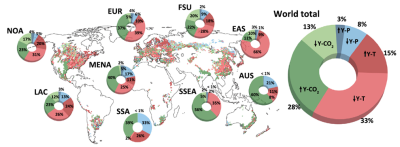Site-Specific Field Management is Needed to Feed the World in the 21st Century
Early planting, increased irrigation, and increased fertilizer application have been proposed as climate adaptation strategies. However, combined and site-specific field management strategies under expected climate change have not been evaluated. Here, we analyzed non-irrigated wheat yield responses to climate change and field management adaptation using a mechanistic crop model evaluated against observed global non-irrigated wheat yield over 13 years at 3749 sites. Early planting with later-maturing varieties provided the most benefit to future yields among the proposed field management adaptation strategies. Improved water use efficiency from increased CO2 led to relatively low benefits of additional irrigation.
Crop yields are controlled by a wide range of interacting factors, driving the need for mechanistic models to explore food production under climate change. Further, rapid climate change and growing population threaten global food security. We estimated that heterogeneous adaption strategies had the potential to improve global wheat yields by 91% by 2100. The yield improvements from combined field adaptation strategies were larger than the sum of improvements from the individual strategies. These synergistic benefits resulted from complementary processes regulating nutrient and water uptake, physiological tolerance to heat stress, and internal carbon and nutrient cycling.
Addressing famine and food shortages are two of the greatest challenges facing mankind due to increases in the world population expected to reach 10 billion by 2050. Over the 21st century, anthropogenic climate change has added and will continue to add, pressure on food security. By comparing mechanistic model projections with a very large observational dataset of non-irrigated wheat yields (13 years at 3749 sites), we showed that more than half of wheat-growing areas will experience yield reductions due to climate change, although global wheat productivity would remain essentially the same as present day. However, the large increases expected in population imply needed increases in food production. Through synergistic interactions between field management strategies (e.g., early planting, increased irrigation, and increased fertilizer applications), we found considerable improvements in global wheat yields can be achieved by adopting spatially heterogeneous and combined management strategies. Early planting with later-maturing varieties provided the most benefit to future yields among the proposed field management adaptation strategies.

